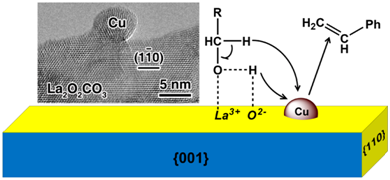A research team led by Prof. Wenjie Shen from State key laboratory of Catalysis, Dalian Institute of Chemical Physics (DICP), Chinese academy of sciences (CAS), identified the key role of the geometrical structure of the Cu/La2O2CO3 interfaces in dehydrogenation of primary aliphatic alcohols. The finding was published in ACS Catal. 2013, 3, 5, 890-894

Geometrical interfacial structure of Cu/La2O2CO3 catalyst. (Image by Fei Wang)
Copper nanoparticles dispersed rod-shaped La2O2CO3 efficiently catalyzed transfer dehydrogenation of primary aliphatic alcohols with an aldehyde yield of up to 97%. This high efficiency was achieved by creating a catalytically active nanoenvironment for effective reaction coupling between alcohol dehydrogenation and styrene hydrogenation via hydrogen transfer. The {110} planes on the La2O2CO3 nanorods not only provided substantial amounts of medium-strength basic sites for the activation of alcohol but also directed the selective dispersion of hemispherical Cu particles of about 4.5 nm on their surfaces, which abstracted and transferred hydrogen atoms for styrene hydrogenation.
This finding provides a new strategy for developing highly active alcohol-dehydrogenation catalysts by tuning the shape of the oxide support and consequently the metal-oxide interfacial nanostructure.
The research was supported by National Natural Science Foundation of China.(Text by Jing Ning)